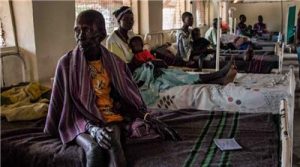Moral Dilemma:
In the case of “Ethics and Humanitarian Aid: Vertical Aid Programs”, Dr. Asadour works in a non-governmental organization (NGO) to help in a “global vertical aid anti-cholera program” (Thomas 267). Dr. Asadour and his team travel to South Sudan with a Memorandum of Understanding to treat cholera exclusively. Patients, with and without cholera, line up at the admissions tent. His moral dilemma arises when deciding who to admit into the hospital.
First, we need to understand the nature of the disease. Symptoms of cholera include watery diarrhea, vomiting, and dehydration. People can die within hours without treatment, so Dr. Asadour will need to act quickly. Also, according to the CDC, cholera “is not likely to spread directly from one person to another”. So long as his team is methodical in their actions with disposing wastes, Dr. Asadour should not worry about cross-contamination. (Center for Disease Control and Prevention)
Dr. Asadour’s moral dilemma involves the ethics of rationing. According to Beauchamp, rationing is “a form of allowance, share, or portion” and is linked to limited resources (Beauchamp 284). This means Dr. Asadour will need to exclude some people from these resources in order for other patients to receive full care. He must set priorities or guidelines as to who is and isn’t admitted to hospitals. Specifically, Dr. Asasdour must set criteria “to determine a qualifying pool of potential recipients” and decide the “final selection of recipients” (Beauchamp 288).
Dr. Asadour needs to assess the symptoms of the incoming patients to see if their symptoms match those of cholera. Although the work station has the supplies to treat other illnesses, the team has a legal obligation to treat patients with cholera only. They could send the extra supplies to the local hospital, but it not ethical to violate the original mandate. “If word gets out that the NGO will treat non-cholera conditions”, the work station will become overcrowded, lose supplies, and must shut down while those inflicted with cholera will remain untreated (Thomas 267).
As for treating patients with cholera, there are many types of rationing to consider. Rationing by age is the most straightforward policy because it includes numerical categories. There are still unethical issues to this method. For example, Dr. Asadour may deem it unethical to admit a seventeen-year-old boy with mild symptoms and refuse admission to middle-age woman with severe symptoms. The “first come, first serve” and the lottery methods are also unjustified in this case because symptom severity varies from person to person.
Dr. Asadour should consider a type of rationing that is involves a direct assessment of each individual patient and their symptoms related to cholera. He can assess each patient individually and personally. Dr. Asadour can use medical insight to determine the needs of each patient. Specifically, he interview the patients and collect information on the severity of their symptoms to determine who is admitted. There are some downfalls to this method. It will be time-consuming and qualitative, meaning Dr. Asadour will have difficulty comparing and ranking patients without numerical values.
Conclusion:
The best solution for Dr. Asadour is to stick to the original mandate of only treating patients with cholera because it is unethical and illegal to abandon the mandate. The NGO made the effort to send the team to South Sudan to treat cholera only, and it will be hazardous if the team abandons their original obligation to treat other diseases. They will risk losing supplies and the work station in its entirety.
Next, Dr. Asadour should assess each patient and determine the severity of their symptoms. Dr. Asadour will then make the decision of who to treat and ration the resources from person to person. Overall, there is no clear and fully ethical policy of rationing resources in vertical aid programs. However, all humanitarian aid workers must understand the joys and the consequences that can come with these programs. Due to scarce resources, workers will have to turn away some to treat others.
Beauchamp, Tom L., and James F. Childress. Principles of Biomedical Ethics. 7th ed. New York, NY: Oxford UP, 2001. Print.
Center for Disease Control and Prevention. “Cholera – Vibrio Cholerae Infection.” Centers for Disease Control and Prevention. Centers for Disease Control and Prevention, 03 Oct. 2014. Web. 12 Apr. 2017.
Thomas, John E., Wilfrid J. Waluchow, and Elisabeth Gedge. “Case 8.2: “Ethics and Humanitarian Aid: Vertical Aid Programs.” Well and Good: a Case Study Approach to Health Care Ethics. 4th ed. Canada: Broadview, 2014. 131-138. Print.





 Dilemma:
Dilemma: